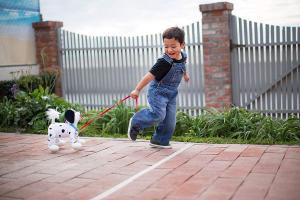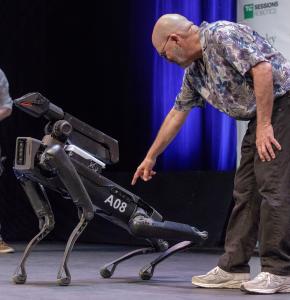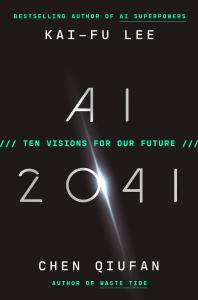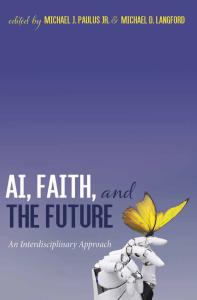
AIs were popular gifts this past Christmas. Some of them were of the barking, tail-wagging variety. Robot dogs are becoming a “thing”. At present, only the more expensive, high-end dogs are equipped with AI, but soon even inexpensive toy pets will become AI’s. Future Christmases are sure to bring more AI pets into more households every year.
The shape of these future pets is uncertain, because technology is advancing on three fronts simultaneously: AI, robotics, and genetic engineering. Each is a game-changer. Who can predict how these technologies will converge? In a previous post I suggested that sci-fi flick, “Blade Runner 2049” is worth a look. That movie imagines a future in which “replicants”, bioengineered humans, emerge as the biggest disruption on the planet. Realistically, it seems a safe bet that animals will presumably be the first replicants. There is a dog in the movie that plays the role of “man’s best friend” to the protagonist, Deckard, played by Harrison Ford. We are left to wonder whether the dog is real or replicant.
In choosing to feature a dog to show how fuzzy the boundary lines will become between real and artificial, I believe the movie is prescient. Dogs have been human companions since prehistoric times. Dogs also have been bred to create an enormous variety of breeds. Now robot dogs also are available in a wide variety of breeds, ranging from the cute and plush toy-store variety, to the clever, trainable, playful AIBO, to the transformer-like working dog from Boston Dynamics.

For some owners robot dogs represent a good alternative to the real thing. They are cute, clever, trainable, and they won’t leave messes on the carpet. As robot dogs become more “life-like”, humans will naturally come to regard them as “friends”. Robot dogs may well be the first human friend-bots to be programmed to obey Asimov’s three laws of robotics.
It’s a good bet that robot dogs will pave the way for more human-like robot “friends”. AI robot dog pet owners will be first to gain life experience relating to robots. It will be interesting to hear their answers to the question: “What’s the difference between having a relationship with a robot or real dog?”
As a good witness to what it’s like to have a relationship with a living dog, I would like to reflect on the memoir written by John Muir. Muir tells the true story of his relationship with Stickeen, the dog who accompanied him on his adventures through Alaska’s glaciers. Muir titles his memoire of these travels simply, Stickeen.
Muir says this Stickeen was the most difficult book to write. He tells the tale of dire hardships endured in the journey to explore uncharted glaciers. The scruffy, little black mutt, Stickeen, was an accidental companion and passenger in a canoeing expedition. Muir and others don’t want to the dog to come along, but his owner was a patron of the journey and insisted. The dog developed the habit of following Muir on his solo hikes wherever he went. The dog seemed content to endure whatever the men endured, “Yet none of us was able to make out what Stickeen was really good for.”
One day, when the canoes are unable to go any further, Muir sets out alone in threatening weather to explore. Stickeen follows him, and Muir tries to chase him away and force him to go back to the camp. The dog persists and Muir gives up the battle.
Muir describes the harrowing journey and danger, as the weather turns from bad to worse. He reaches the edge of
“the most dangerous and inaccessible [glacier] that ever lay in my way… Of the many perils encountered in my years of wandering on mountains and glaciers none seemed so plain and stern and merciless as this. And it was presented when we were wet to the skin and hungry, the sky dark with quick driving snow, and the night near. But we were forced to face it. It was a tremendous necessity.
“But poor Stickeen, the wee, hairy, sleekit beastie, think of him!”
Muir eventually crosses a knife-edge ice bridge by cutting steps in the ice by hand. He commands the dog to follow, but it refuses, and runs away “moaning and wheeling as if in bitterness of death.”
Muir all but loses hope of seeing the dog alive again. He prepares himself to abandon the dog in an effort to get himself back to camp before dying of exhaustion, cold, and hunger. At last, Stickeen decides to try the crossing. Muir watches, and encourages the little beast to continue. It picks its way gingerly across and finally takes the last step in a leap to safety. “And now came a scene!” Muir says,
“Well done, well done, little boy! Brave boy!” I cried, trying to catch and caress him; but he would not be caught. Never before or since have I seen anything like so passionate a repulsion from the depths of despair to exultant, triumphant, uncontrollable joy. He flashed and darted hither and thither as if fairly demented, screaming and shouting, swirling round and round in giddy loops and circles like a leaf in a whirlwind, lying down, and rolling over and over, sideways in heels overhead, and pouring forth a tumultuous flood of hysterical cries and sobs and gasping mutterings. When I ran up to him to shake him, fearing he might die of joy, he flashed off two or three hundred yards, his feet in a mist of motion; then, turning suddenly, came back in a wild rush and launched himself at my face, almost knocking me down, all the time screeching as if saying, “Saved! saved! saved!”
Perhaps a robot dog could be programmed to mimic such behaviors, but why? Perhaps a robot AI could learn to disobey human commands, but how? Perhaps a robot dog could decide to expend its last precious bit of battery power to jump, dance and rejoice when saved from death, but what would it mean?
Muir offers this insight at the end of the book:
“I have known many dogs, and many a story I could tell of their wisdom and devotion; but to none do I owe so much as to Stickeen. At first the least promising and least known of my dog-friends, he suddenly became the best known of them all. Our storm-battle for life brought him to light, and through him as through a window I have ever since been looking with deeper sympathy into all my fellow mortals.”
This is the deep significance of relationship. The supreme gift of friendship is to grow more human—to look with deeper sympathy into all our fellow mortals. Perhaps someday robot friends and pets will be capable of bringing this gift. For the moment this seems to be the special province of mortal pets and mortal persons.












